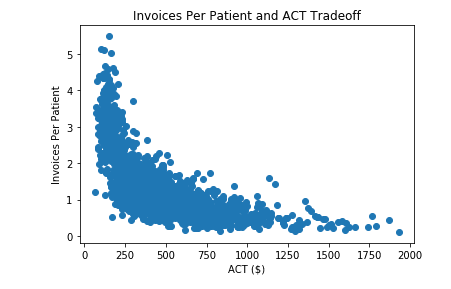One of the best things about math, specifically data analysis, is its ability to tease out truth from speculation. There are a lot of schools of thought on the best way to increase veterinary revenue, with Average Client Transaction (ACT) historically reigning supreme across the industry. Well, thanks to a new statistical model, initial findings suggest that Invoices Per Patient (visits) have a greater effect on increasing Revenue Per Patient than Average Client Transaction (ACT).
 Veterinary revenue model explained
Veterinary revenue model explained
A statistical model can be defined as a way to describe the relationship between a set of factors and the desired outcome. For example, price, quantity, and flavor could be factors in the desired outcome of purchasing ice cream.
This new veterinary model comes from our very own data analysts at VetSuccess. Since 2011, we’ve been making sense of and normalizing veterinary PIMS data, which uniquely positions us to tackle these tough questions armed with data.
Our analysts utilized 2019 veterinary practice data from around 2,000 practices connected to VetSuccess. Focusing on annual Average Revenue Per Patient to represent revenue growth, the model specifically analyzed Invoices Per Patient and Average Client Transaction while controlling for county income per capita.
With the technical stuff out of the way, we can get to the good stuff: the findings!
Initial findings from the statistical model
The new model uncovered some interesting initial findings that somewhat contradict popular industry opinion.
Initial findings show the following:
- Invoices Per Patient and Average Client Transaction both correlate with increased revenue, but Invoices Per Patient showed to have a greater effect on Revenue Per Patient than Average Client Transaction. Visits (Invoices Per Patient) account for about two-thirds of Revenue Per Patient, whereas ACT accounts for about the remaining one third.
- Average Client Transactions of $300 or more negatively impact Invoices Per Patient. We see fewer and fewer visits (Invoices Per Patient) when ACT surpasses $300.
What does this mean?
 Many in the industry label ACT as the key measurement for revenue growth.
Many in the industry label ACT as the key measurement for revenue growth.
While ACT is certainly not something to neglect, these initial findings suggest that it may be wise to place greater emphasis on increasing the number of invoices (visits) associated with each patient.
The findings also suggest that clients do have a price point threshold, which when crossed can negatively impact invoices per patient, ultimately impacting revenue per patient.
Where do we go from here?
This analysis has raised many interesting questions:
- How does Revenue Per Patient impact overall practice revenue?
- Do patients that visit more receive more services?
- Should practices focus on spreading out visits and decreasing ACT?
- Could separating non-service costs, such as parasiticide prevention, help decrease ACT and drive more visits?
Further analysis is in the works here at VetSuccess to dig into these questions and more. Additional controls for other factors such as practice size will be included and more comprehensive analysis will be available by the end of the year. Stay tuned!



